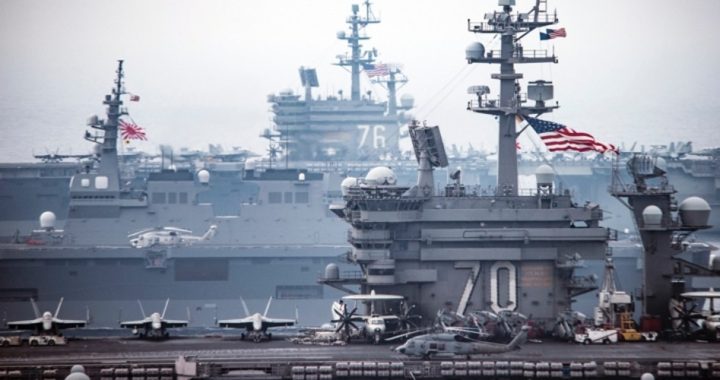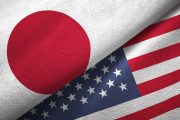
North Korea’s official Korean Central News Agency (KCNA) announced on June 9 that the communist state had test-launched a new type of cruise missile capable of striking U.S. and South Korean warships off its coast. The test may have been intended to send a threatening message to the United States, which has two carrier strike groups in the waters between the Korean peninsula and Japan, with a third carrier group now being sent to the region.
“This new-type cruise rocket is a powerful attack means capable of striking any enemy group of battleships” attempting to attack North Korea and can be used “at will,” KCNA said.
USA Today reported that North Korean leader Kim Jong-un observed the launches, according to KCNA, which said the missiles “accurately detected and hit” floating targets at sea after making “circular flights.”
South Korean observers said the missiles traveled about 125 miles before splashing down in waters between the Korean Peninsula and Japan, where the U.S. aircraft carriers USS Carl Vinson and USS Ronald Reagan participated in joint exercises with the South Korean Navy that ended earlier this week.
South Korea’s military spokesman, Roh Jae-cheon, said the launch was intended to show off Pyongyang’s widening array of missiles and its “precision strike capabilities” against ships — in response to the recent joint drills conduct by his country and the United States.
In a May 27 article, Voice of America (VOA) reported that the USS Nimitz will join the Carl Vinson and the Ronald Reagan and their accompanying ships that make up carrier strike groups in the western Pacific.
The Washington Post reported on June 9 that the missiles are the fourth new missile system that North Korea has unveiled and tested this year, indicating that the communist state will continue to pursue a weapons program that has caused much concern among its neighbors and the United States.
Just one day before this latest North Korea missile test, Vice Admiral James Syring, head of the U.S. Missile Defense Agency, told the House Armed Services Committee that the United States “must assume that North Korea can reach us with a ballistic missile.”
“I would not say we are comfortably ahead of the threat,” said Syring, acknowledging the surprising progress that North Korea has made in developing the range of their missile forces.
“The advancements in the last six months have caused great concern to me and others in the advancement of and demonstration of technology of ballistic missiles from North Korea,” said Syring.
The type of anti-ship cruise missile that North Korea tested on June 9 is designed to fly at a low altitude, making it a potent weapon against ships. Argentina used a missile of this type, the French-built Exocet, to destroy a British guided-missile destroyer during the Falkland Islands War in 1982.
North Korea has also tested medium-range ballistic missiles that could strike the U.S. base on Guam. A greater concern, however, is that North Korea is attempting to produce an ICBM carrying a nuclear warhead that would threaten not merely Guam, but the mainland United States.
It is apparent that these threats have motivated the U.S. Missile Defense Agency (MDA) to accelerate its testing of ground-based interceptor missiles (GMD) capable of destroying an ICBM mid-flight. In fact, the MDA, in cooperation with the U.S. Air Force 30th Space Wing, conducted a successful test of the GMD system on May 30, when a ground-based interceptor launched from Vandenberg Air Force Base in California intercepted an ICBM-class target launched from the Reagan Test Site on Kwajalein Atoll in the Republic of the Marshall Islands.
Though the development of a reliable GMD is certainly encouraging, no such system is 100-percent foolproof, especially against an attack involving multiple missiles and decoys. Therefore, a show of strength is the best deterrent against North Korea, and must include sending Pyongyang the message that the United States will not hesitate to use every tool in its arsenal against the communist state if it should provoke us with an attack. Might is something that even a power-mad tyrant such as Kim Jong-un can understand.
Photo: AP Images
Related articles:
In Test That Will Send Message to N. Korea, U.S. Successfully Intercepts ICBM
N. Korea Continues Missile Tests; U.S. Moves 3rd Carrier Strike Force to Western Pacific
North Korea Tests Another Missile, Says They Are Ready to Deploy
North Korea Tests Ballistic Missile Capable of Reaching U.S. Base on Guam
North Korea Threatens U.S. With “All Out War” and “Weekly Missile Tests”
North Korea’s Letter to Congress Says Pyongyang to Speed Up Nuke Program in Response to Sanctions
As N. Korea Celebrates Anniversary of Military, S. Korea Is on Alert
North Korea Threatens to Attack U.S. Carrier Group; Detains U.S. Citizen
Russia Says Troop Movement Near North Korean Border Was Scheduled
North Korea Warns of Nuclear Retaliation at Any Sign of U.S. “Aggression”
North Korea Admits Missile Launches Were Test of Possible Strike Against U.S.Bases in Japan
North Korea Missile Test Draws Reactions From Trump, Abe, and UN
North Korea Claims to Test H-Bomb
North Korea Postures With Nuclear Warning, Movement of Missiles



